Menu
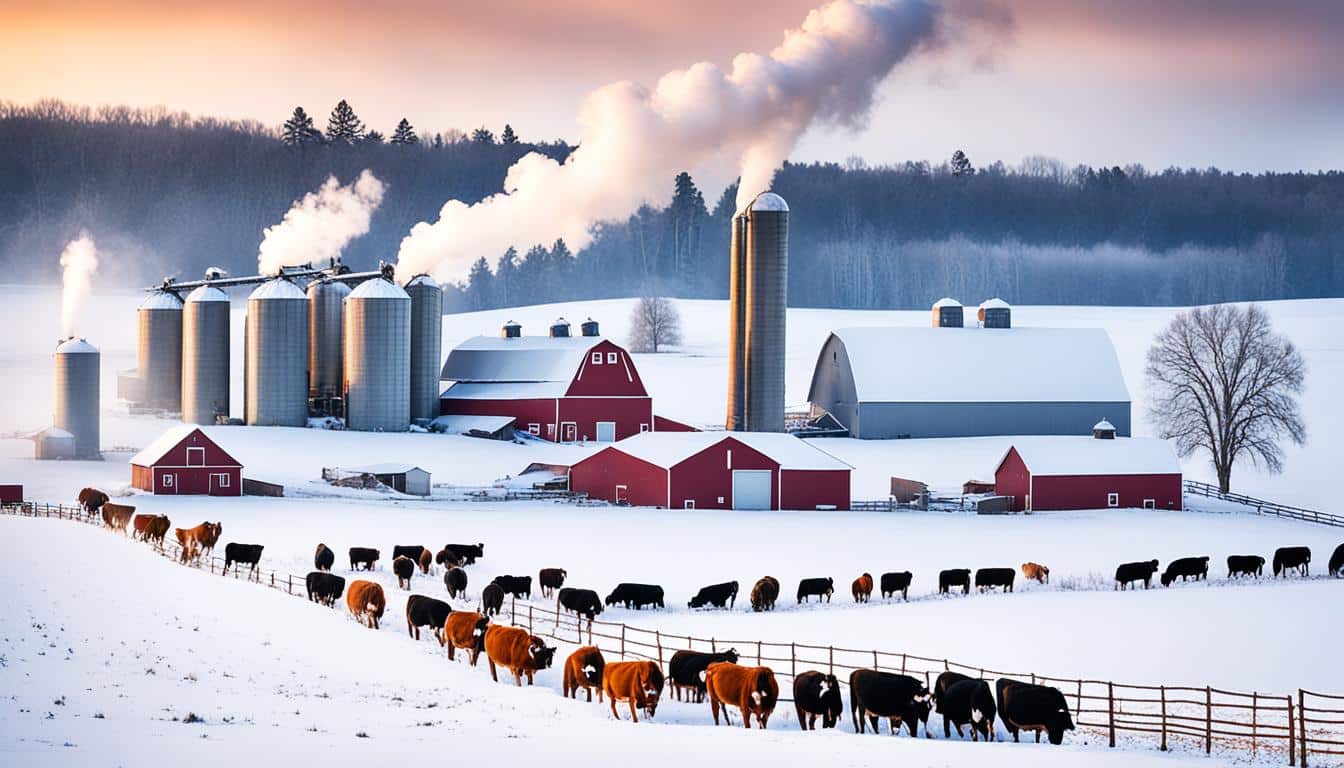
Climate change could cut global farm output by 17% by 2050. This makes improving farming methods, especially in winter, crucial. In places like Brazil, warming climates could make growing coffee 95% harder in some areas. This calls for smart, adaptable farming solutions.
Systems that combine crops, animals, and trees bring hope. They make farms more sturdy and improve the local climate. Fixing old pastures boosts farming and helps the planet cope with climate change. Also, planting trees among crops helps with weather extremes and keeps the soil and water healthy all year.
Using forests in smart ways can capture carbon and make the ground better. But it also means seeing more forest fires. Brazil needs to fix about 21 million hectares of forests. Doing this could bring big benefits for the economy and nature.
Winter farming needs a smart plan to grow crops well in tough weather. Good crop management boosts how much farmers grow, even in winter. By carefully planning and working hard, farmers can beat winter’s challenges.
Around 85% of farmers say their crops face cold stress in winter, making them grow slower and less. This shows why it’s vital to use farming methods that help crops cope with the cold. Planting seeds well, fertilising right, and preparing the soil all help crops grow stronger and bigger.
Using mulches and covers can make a better, warmer space for plants, saving them from sudden cold. It’s key to look after each crop’s special needs carefully in winter.
For successful winter harvesting, important practices are pest control, watering, and picking crops at the right time. These are key to keeping crops healthy and productive
Companies like AWSM help winter farming by clearing snow and spreading grit, making sure the farm runs well. Renting ploughing equipment from such services offers an easy way for farmers to ready their fields in winter.
Techniques like conservation tillage and planting different crops together improve soil and harvests in the cold. Paying close attention to local weather can also improve how winter crops do.
Winter farming success needs tough plants that handle cold and careful planning. Farmers boost their resilience and efficiency by choosing these crops wisely. This helps them face the challenges of winter with better results.
The right plants are crucial for good winter farming. In 2019, the Californian Central Valley faced a threat to its $2 billion citrus crop from temperatures as low as 24 to 25 degrees Fahrenheit (-2.78 Celsius). Plants like broccoli and kale do well in cold. They help keep farms productive even when it’s chilly.
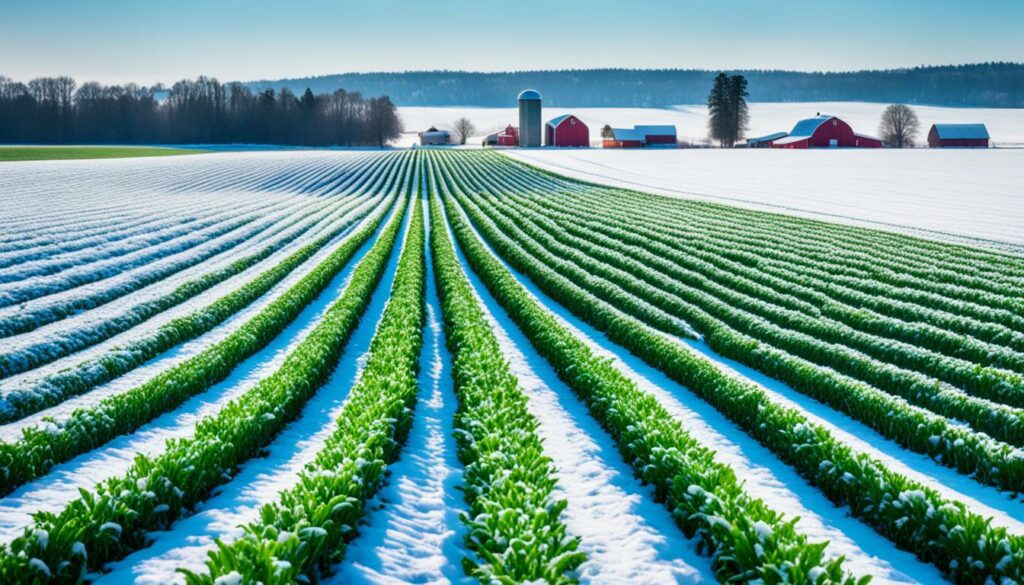
There are also new ways to make plants tolerate cold better. For example, cellulose nanocrystals from plant fibre can make crops handle cold up to 6 degrees more. This led to a 40% better fruit yield in cherries. These advancements play a key role in making farms more resilient against deep freezes.
Getting the planting and harvesting times right is vital. Crops must be planted deep enough to get the moisture they need as they grow. Using no-till practices helps keep the soil in good shape. This is important when dealing with winter’s harshness. Harvesting at the right time, especially with machines, ensures the best results. For example, all winter wheat, barley, and oats in Great Britain were harvested by September 2023.
| Technique | Advantages |
|---|---|
| Selecting Cold-Resistant Crops | Enhances yields by up to 40%, improves cold tolerance. |
| Using CNC Technology | Increases cold tolerance by 6 degrees, especially beneficial for fruits. |
| No-Till Practices | Maintains soil integrity and supports moisture retention. |
| Proper Planting Depth | Ensures adequate moisture during germination. |
Putting cold-resilient crops with proper planting and harvesting almost guarantees success in winter farming. It significantly raises harvesting efficiency and the farm’s ability to withstand winter’s challenges.
For winter, sustainable farming is key. It includes regenerative techniques and mixed crop-animal systems. These not only help adapt to climate change but also boost farm output and strength. They fight off the bad effects of the changing weather, keeping farms going in winter.
Regenerative farming taps into the power of healthy soil naturally. It uses minimal soil disturbance, cover cropping, and crop rotation. Together, they make soil better and more full of nutrients. This boosts nutrient use by 20%, leading to more crops and lower costs.
Using these green strategies can raise crop yields and farm profits by 5-7%. There’s even a way to cut your carbon use by 20%. That’s thanks to using fewer chemicals, helping the planet too.
Joining crops with animals does a lot for a farm in winter. It helps the ground stay healthy, cuts waste, and makes the whole farm stronger. This mix creates a natural balance that’s good for everything growing and living there.
Animals in the field also give back by natural fertilising with their manure. This puts precious organic matter into the soil, making it better for growing crops. Studies show this way can even make a farm more productive. Then, you don’t need as many artificial fertilisers.
These systems prepare a farm for season changes by making more than one kind of product. Plus, they help cope with price and climate surprises. By saving water and fertilisers, for instance, a farm can do its bit for the planet too.
Yara believes in these sustainable ways because they help farms stay strong and green. Using regenerative farming and mixed farming methods is how we prepare for a changing climate and keep our farms alive.
Keeping crops safe from frost in winter is crucial for farming. Farmers use various frost protection strategies to protect crops from cold. This helps keep plants healthy and boosts harvests.
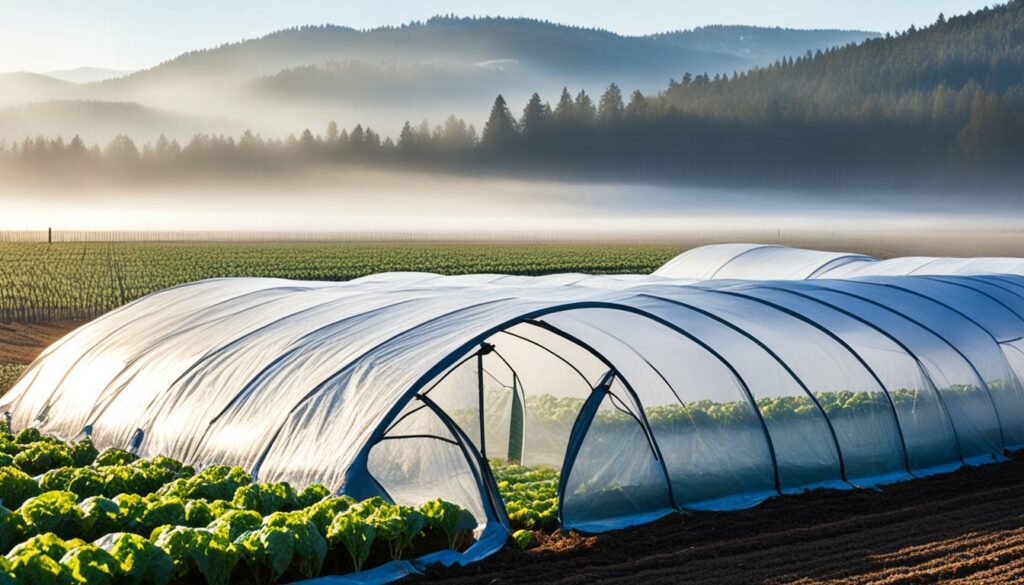
One great method is using row covers and mulch. They form a shield against the chill, making the air around crops 3 to 5 degrees warmer. In places like Georgia, farmers choose row covers carefully based on the location’s elevation.
If plants like strawberries are at risk, using straw mulch helps a lot. It keeps the plant’s roots and crown warm. But, plastic mulch isn’t the go-to for frost protection, even though it boosts soil warmth around the plant.
Using covers and mulch is good, but adding windbreaks and shelters is also crucial. They protect plants from icy winds that worsen frost harm. These structures lower the wind’s force, creating a safe area for crops. They stop temperatures from falling to frosty levels, especially important for plants.
By combining row covers, windbreaks, and shelters, you create the best frost protection plan. This plan keeps the right temperatures for crops. It helps farming go on through winter, making the growing season longer.
Overall, adopting these strategies effectively extends the growing season and enhances the potential for healthy yields, even under adverse winter conditions.
| Frost Type | Temperature Range (F) | Potential Damage to Plants |
|---|---|---|
| Light Freeze | 29 to 32 | Can kill young and frost-tender plants |
| Moderate Freeze | 25 to 28 | Cold enough to damage most plants |
| Heavy/Severe Freeze | 24 and below | Heavily damages most plants |
Using these frost protection methods is key for a strong winter farming period.
It’s key to understand how snowfall impacts farming. This is crucial for maintaining agriculture productivity in winter. Late snow can push back spring work by 7 to 14 days. This change greatly affects farming plans and output.
When heavy snow comes with lots of water, it’s mostly good for the soil. It can make the ground moist. But, too much cold from the snow brings its own problems. Without enough snow, winter crops can die, harming the next year’s harvest.
There are high-tech solutions for these issues. For example, the iMETOS ECO D3 station helps track snow and air conditions. This helps farmers know when it’s best to plant or care for their crops. Such tech lessens the blow of snow’s challenges.
Some farmers are already reaping the rewards of using snow tech. One farmer saved money on fertiliser with help from METOS IoT. Their savings equalled more than 6 times their investment in some years.
Places like the Nordic countries, Canadian Prairies, and the US’s mountain areas regularly face these challenges. So do the Alps and Siberia. They battle heavy snow and freezing temperatures.
Snow helps balance these harsh conditions in agriculture. It protects crops from extreme cold. This ensures plant’s continued growth, offering some relief to farmers.
| Region | Winter Conditions |
|---|---|
| Nordic Countries (Norway, Sweden, Finland) | Long, harsh winters with heavy snowfall |
| Canadian Prairies (Alberta, Saskatchewan, Manitoba) | Cold winters, significant snowfall |
| Rocky Mountains and Sierra Nevada (USA) | Cold snaps, heavy snowfall |
| Siberia, Russia | Extremely cold temperatures, heavy snowfall |
| Alpine Regions (Switzerland, Austria) | Prolonged winters, substantial snowfall |
Keeping livestock healthy in winter is vital for their wellbeing and the farm’s future. Extreme cold can make animals need a lot more food to stay warm and active. It’s important to feed them well, giving extra forage and adjusting their diet for the colder months.
Cold weather means animals need more water too, so it’s key to keep their water supply unfrozen. Adding heat to water tanks can stop them from turning into ice. This keeps animals hydrated and healthy.
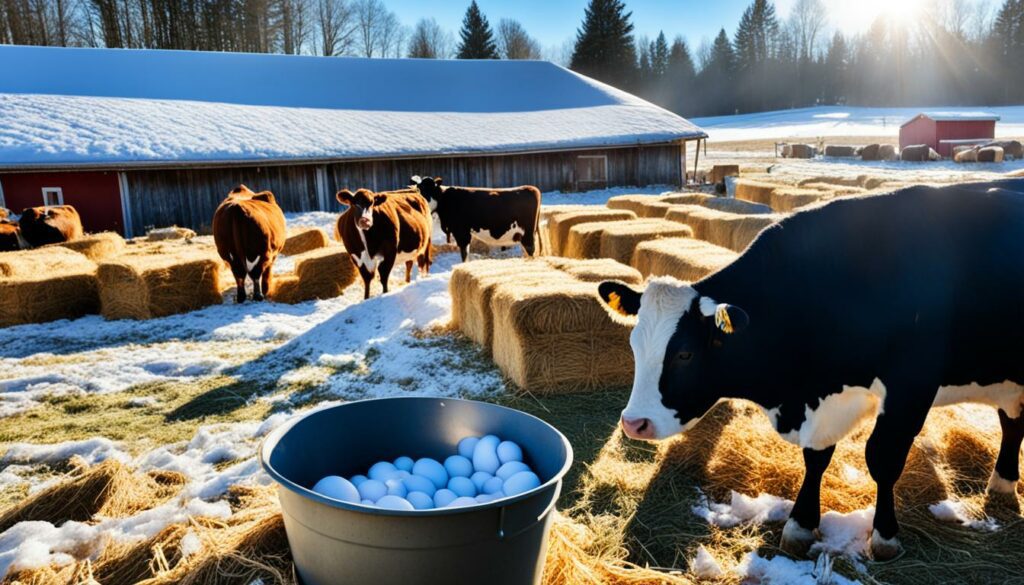
Shelter and protection from the wind are crucial. Trees like fir and juniper can act as natural barriers against cold winds. Good shelter ventilation is also important. It helps keep the air fresh for the animals, lowering the chance of them getting sick.
Smaller animals and the old or very young need extra care in the cold. They can’t handle low temperatures as well and are at risk of getting covered in snow. Keeping them warm and dry, and checking on them often, is essential. For bigger animals, a warm and dry place to sleep is enough in many cases. Still, they too need checking, especially in bad weather, to avoid sickness.
Comfortable and clean bedding is a must for all animals in winter. It keeps them warm and less stressed. Regular health checks and the right food can help animals keep their strength over winter.
| Livestock Type | Water Consumption (Litres/Day) |
|---|---|
| Beef Cattle (Mature) | 38-57 |
| Dairy Cattle (Lactating) | 68-104 |
| Horses | 30-45 |
| Sheep | 6-9 |
| Swine | 11-19 |
Farmers who follow these steps and look after their animals well will see good results. Their livestock will be healthier, and their farms more sustainable.
Maximising winter farm productivity is key. Effective greenhouse heating methods are a must. They protect crops, ensuring growth in cold months.
Solar heating is efficient and eco-friendly. It uses solar water heating panels to warm the greenhouse. This method cuts down fossil fuel use and supports sustainable farming. Geothermal heating uses the earth’s stable temperatures. Water circulates through underground pipes, bringing warmth to the greenhouse. This process maintains ideal conditions for plant growth.
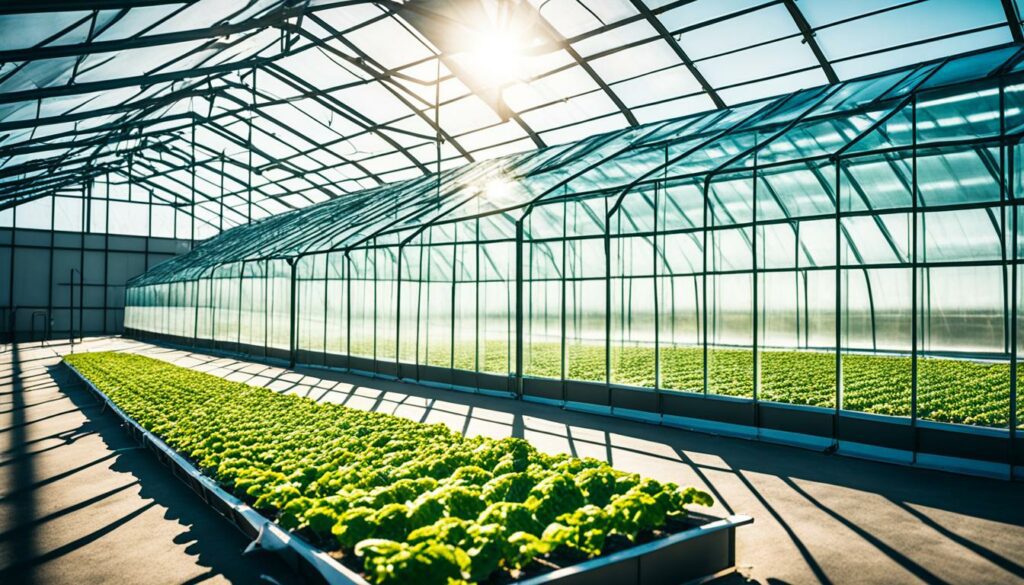
Using biofuel and biomass heating is a renewable option. It burns organic materials to produce heat. This cuts dependence on non-renewable sources and handles agricultural waste. These heating methods maintain the ideal greenhouse temperature. That’s critical for multiple species in the range of 68 to 78°F. They help farms grow through winter and increase resilience to extreme weather.
| Heating Method | Advantages | Disadvantages |
|---|---|---|
| Solar Heating | Eco-friendly, reduces fossil fuel dependence | Initial setup cost |
| Geothermal Heating | Stable, reliable heat, low operational costs | Expensive installation |
| Biofuel and Biomass Heating | Renewable, manages waste, consistent heat supply | Requires continuous fuel supply |
Exploring different heating methods like solar, geothermal, and biofuel and biomass helps. Farmers can make their greenhouses sustainable and productive in winter. These methods boost greenhouse farming’s efficiency and lifespan.
Fixing degraded pastures is vital for sustainable winter farming. We plant native forage and grasses to restore soil nutrients and improve health. This boosts the quality of pastures and makes farming more resilient.
Native plants are key in fixing damaged pastures. They boost soil nutrition and structure naturally, without lots of chemicals. This method also keeps the variety of life that’s needed for a healthy environment. By using this approach, we can avoid adding more fertilisers every few years.
Trees are crucial for stopping erosion. Their roots help keep soil in place and stop water runoff. Adding trees to pastures also makes the local area’s weather better. This leads to more stable temperatures and rain levels, which help crops and animals.
When we combine planting native plants and trees, we help the land heal. This boosts farm productivity, helps the environment, and fights climate change. Managing pastures well is key to making farms stronger and protecting our planet.
Maximising winter crop harvesting is key for good farm yields. It helps avoid losing crops to bad weather or damage. Choosing the right crops for easy harvesting is crucial, especially when the weather is bad.
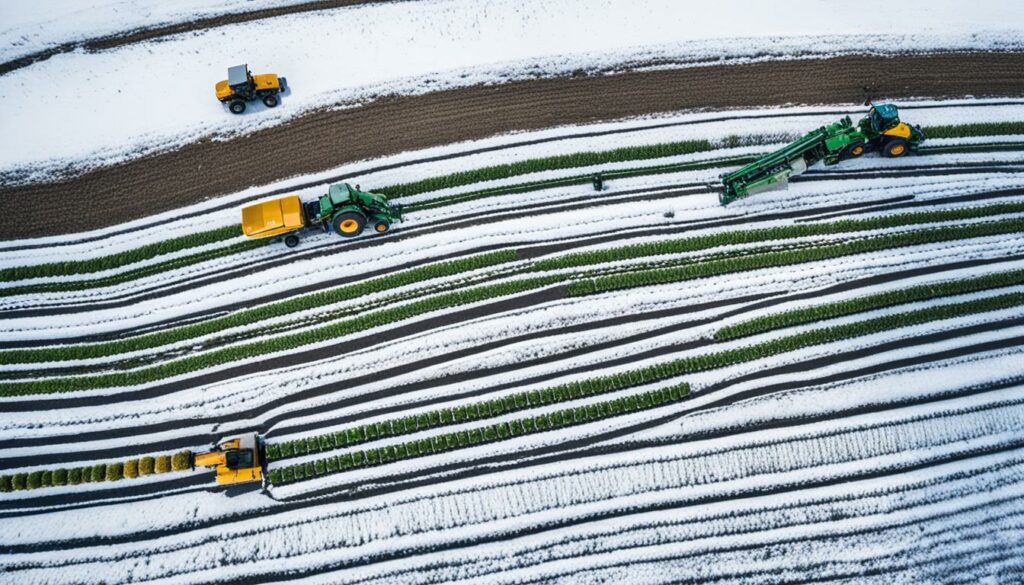
Using smart farming techniques boosts crop numbers. Technologies like micro-sprinklers and drip irrigation save a lot of water. This can mean up to a 95% better use of water.
When planting, how you prep the soil makes a big difference. It’s important for seeds to have enough water to grow well. Some ways of planting without digging a lot can make soil healthier. Healthy soil means better crops over time.
Good care after harvesting is also vital. Keeping the right moisture levels stops pests and keeps your crops good. Following these steps can make a big difference in how much you produce and earn.
In winter, the natural rain is often not enough for crops. It’s key to use water wisely to help crops grow well. By using water at the right times for plants, we make sure they get what they need most. This way, we use water better and keep the plants healthy.
Using advanced watering like drip systems is great for plants. Drip systems can cut water use by 29% over older ways. Also, micro-sprinklers can make crops yield more and use water better. With these methods, we make every bit of water count.
When we water plants also matters a lot. Doing it when it’s less hot means water doesn’t just evaporate away. This saves water and helps plants grow in the cold.
Here’s a look at different crops and how they do with irrigation in Utah:
| Crop | Year | Method | Costs ($/acre) | Returns ($/acre) |
|---|---|---|---|---|
| Alfalfa (Flood) | 2015 | Flood | 500 | 650 |
| Soft White Wheat | 2015 | Flood | 400 | 520 |
| Safflower | 2019 | Sprinkler | 450 | 580 |
| Non-Irrigated Flax | 2022 | None | 200 | 300 |
The table above shows how smart watering can save water and make more money. By focusing on good water use in winter, farmers make sure their fields are doing well. They do this despite the winter’s challenges, helping their crops grow.
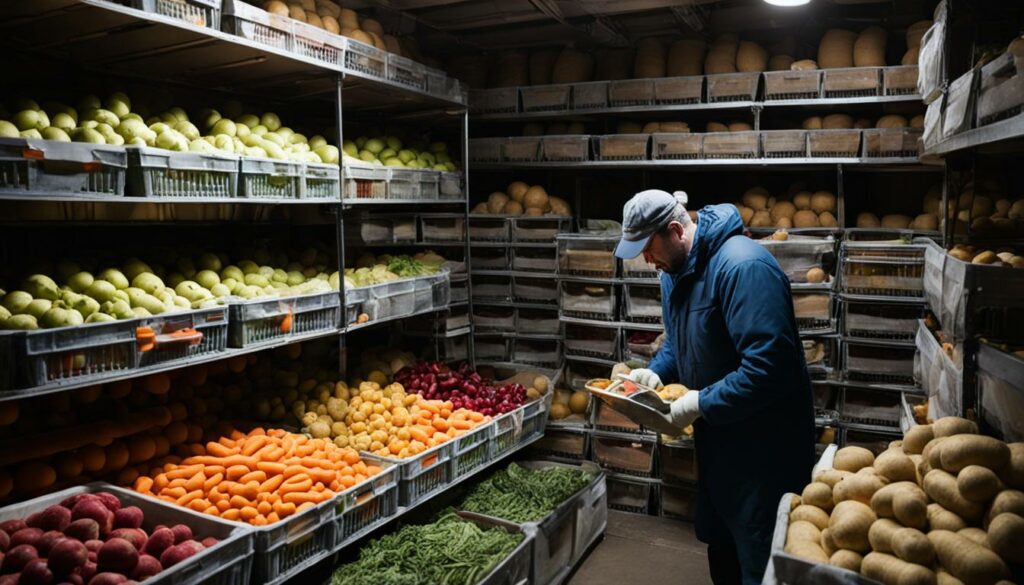
Proper post-harvest storage is key for winter crops. It’s crucial to keep the crops dry and free from pests. This keeps them fresh and of high quality for longer. Storing crops at the right moisture levels prevents them from spoiling.
Keeping pests away from the storage area is important. This includes placing traps and fixing any holes where pests might enter. It’s also key to keep a clear record of how you deal with pests. Cleaning tools and equipment properly also helps to avoid bacteria buildup.
To avoid contamination in wash and pack areas, follow key steps. Keep cleaning products and pesticides separate and clearly labeled. Also, have Safety Data Sheets handy for any sudden needs. Using the right lubricants and chemicals reduces the risk of contamination in crops.
For safety against chemical and physical hazards, regular checks are a must. Use the correct cleaning products that are safe for food areas. Adjusting storage conditions to fit each crop’s needs keeps them in good shape. Doing this preserves their value and quality, especially after the winter harvest.
Agroforestry systems boost farm productivity in winter in many ways. One great example is combining phalsa with mung bean and potato. This setup achieved the best outcome, showing how agroforestry system integration increases farm output.
Karonda with mung bean and potato also excels. It achieved the highest net return and used water efficiently. Phalsa with cowpea – mustard and Moringa with mung bean – potato provide rich soil and boost biodiversity.
Agroforestry fights climate change too. The phalsa with mung bean and potato system is very good at this. It has the best C sustainability index and helps store carbon in the soil. These systems support farming all year in a stable, diverse way.
With the world’s population growing, these systems are more important than ever. They make farms stronger and more varied. For example, Romania’s 40-hectare silvopastoral system supports biodiversity well.
Denmark’s system mixes arable crops with trees on 11.1 hectares. This improves soil and water and boosts overall productivity all year round.
| System | Productivity (Mg/ha) | Net Return (US$/ha) | Water Use Efficiency (kg/ha-mm) |
|---|---|---|---|
| Phalsa + Mung Bean – Potato | 25.9 | N/A | 33.0 |
| Karonda + Mung Bean – Potato | N/A | 3529.1 | 33.0 |
To sum up, agroforestry systems are key for farms. They help with biodiversity, productivity, and coping with climate change. By adding trees to their crops, farmers can make the most of their land, produce sustainably, and help the environment.
It’s vital to improve soil during colder months to keep crops growing well. Using methods that care for the soil helps a lot. Cover crops are a great way to do this. They make the earth richer, keep it healthy, and help crops grow better.
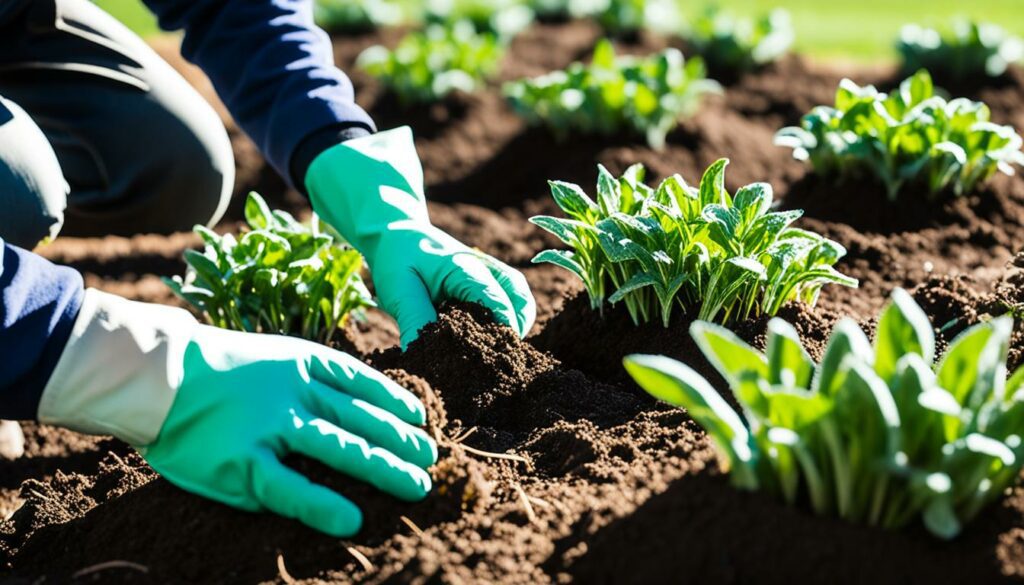
The Northeastern United States faces more heavy rain. This makes good soil quality even more important. Cover crops make the ground absorb rain better and stop it from washing away the soil. They also help keep the soil full of water, which is very useful in dry weather.
Cover crops do more than just help the soil with rain. They make the soil hold water and improve how it soaks up rainfall. This is super important when there’s a lot of rain. They make the soil stronger against floods. This matters a lot right now, with big floods happening in many places.
Cover crops also stop the soil from getting too dense. This lets air into the ground, which is good for the soil. They stop heavy rain from hurting the soil too. This keeps nutrients from the soil in place, not running off. This way, the water near the farms stays clean, and the soil stays good for growing plants. Even though it costs money to plant these crops, the good they do for the soil is worth it.
These crops do more than just help the soil. They make the farm a better place for nature. They bring in helpful bugs, stop bad bugs from spreading, and lock away carbon that could hurt the air. All of this makes the farm work better all year round.
So, using cover crops is really helpful in winter. They make the soil richer, keep it strong, and help crops grow more. This is a smart move for farmers who want to do well, even when it’s cold outside.
| Benefits of Cover Crops | Greater Crop Stability | Increased Soil Organic Matter | Improved Soil Fertility | Enhanced Water Retention | Soil Erosion Prevention |
|---|---|---|---|---|---|
| Reduced Nutrient Runoff | Lower Soil Compaction | Better Rain Absorption | Increased Crop Yields | Reduced Water Pollution Risks |
Using cover crops and other good farming ways keeps the soil healthy and strong. Even in winter, the farm stays productive and safe. So, farmers should use cover crops and look after their land. This is key to farming well and protecting the future.
Advanced technological innovations are key to moving winter farming advancements forward. Things like precision agriculture, farm management software, and seed technology greatly increase productivity in cold months.
Precision agriculture is vital for detailed crop health surveillance. It uses UAV imagery and LiDAR technology. UAVs offer aerial views for precise checks, and LiDAR helps measure crop factors like canopy thickness.
Agriculture technology with IoT sensors improves resource handling. These sensors give live updates on soil conditions and more, leading to smart decisions. Studies show that using IoT tech boosts productivity during winter by making various farming tasks smoother.
Additionally, AI and machine learning boost data analysis. They handle large data amounts to forecast crop outcomes. They also help with planting times, making sure all farming efforts are as effective as possible.
Tech companies and farmers working together provide tailored solutions for winter farming advancements. This teamwork helps solve cold-weather issues like protecting against frost and using water efficiently.
The Food and Agriculture Organization (FAO) warns that we need to significantly up our food production for a world with 9.1 billion people by 2050. This means we must use all available tech to increase crop yield.
| Technology | Application | Benefit |
|---|---|---|
| IoT Sensors | Soil moisture and temperature monitoring | Efficient resource management |
| UAV Imagery | Aerial crop health monitoring | Accurate crop assessment |
| LI | Crop parameter estimation | Enhanced yield prediction |
With climate change challenging farming, adopting winter farming advancements and agriculture technology is crucial. These tools help farmers achieve stable productivity during winter, ensuring food security worldwide.
Winter farming brings its own set of challenges. To face these, it’s crucial we have strong and smart plans in place. We must be aware of the risks, especially those tied to climate change. For example, while crops like wheat may see 30% more yield by the 2050s due to warmer seasons, they could actually face losses. These losses are big, reaching up to 40 million tonnes or US$5 billion in reduced crop production since 1981.
Sustainable farming is key. It involves using the best methods, like how to manage crops and protect them from frost. Adding animals to the farm can also help. This approach can make winter farms more stable. It’s important to note that a rise of 2°C in some areas could mean more wheat. But, in warmer areas, this could mean less wheat grown. Each year, the rain and extreme heat changes a lot. Because of this, farms need to be ready to change and adapt.
Technology plays a big role in helping farms. For example, new ways to grow wheat could see a huge boost in yield by the 2050s. This is great news for winter farms. Even small changes in managing temperatures can make a big difference, especially where it’s usually warm. Modern tech is vital as we expect the weather to change. We should be ready for mean annual temperatures to go up by 2020 and, later, by 2050 too.
To make farms ready for winter, we need to use many different methods. These include eco-friendly farming, protecting crops from bad weather, and using high-tech solutions. By pulling all these together, farmers can be not just ready but also set for success, every winter. The real way to keep farms running and growing well in the winter is to always be ready to learn and try new things.
Start by choosing plants that love the cold. Change when you plant and pick your crops. Use smart farming that gives back to the land, and cover your plants from severe weather. Heat your greenhouses and mix in trees with your crops. This will all help your farm do well in winter.
Try farming techniques that fit the season. Take good care of your crops by preparing the ground well and giving them the right food. Make sure you harvest at the best times. Keep the cold away from your plants and water them just right.
Pick crops that are tough and can take the cold. Certain kale, carrots, and winter wheat are good examples. Talk to farmers close by for what works best in your area.
Change when you plant and harvest to match the best soil and weather times. Try not to dig up the soil too much and put your crops in deep enough to avoid frost. Harvest on time to beat bad weather and keep your crops healthy.
Use farming methods that help the land and keep it going through winter. Combining crops and animals helps the soil stay strong and keeps the farm going well. Try not to disturb the soil too much.
Cover your crops and spread mulch to keep them warm. Windbreaks and shelters stop winter winds from harming your plants. This all helps to make a nice place for plants to grow.
Snow can be good since it keeps plants warm. But too much snow causes problems like planting being late or not getting your crops out on time. It also adds too much water and gets in the way of hard work.
Make sure your animals have a cosy place, good food, and plenty of water. Use windbreaks, give them extra food, and stop the water from freezing. This keeps your animals healthy in the winter.
Use the sun and the heat from underground to warm your greenhouse. Burn clean plant fuel and use plant leftovers to heat. This keeps your plants growing all year without using too much fuel.
Growing local grasses helps the soil get better and stops it from washing away. Trees also help by making a better space for plants and animals. This is good for the soil and for the air.
Harvest early to keep as much of your crop as possible. Choose plants that are easy to pick with machines. Keep your crops stored just right to sell them at their best.
Water your crops just when they need it using systems that don’t waste. This saves water and helps your crops grow well even when it’s cold and dry. It’s good for your farm and for the planet too.
Keep crops in the perfect condition to stop them from spoiling. Each crop needs a different way to be stored well. This keeps your food nice to eat and easy to sell.
Plant trees alongside your crops to bring in money all year and to keep nature healthy. Trees make the soil better and help your farm stand up to bad weather. They also bring in bees and make your farm stronger.
Cover the ground with plants, change your crops often, and leave the roots of old plants in the soil. This makes the soil hold more water and food, which your crops need, especially in winter.
New tech helps you farm better by looking after your crops and resources. It gives you up-to-date advice on what to do. This is key for keeping your farm growing in winter and changing climates.